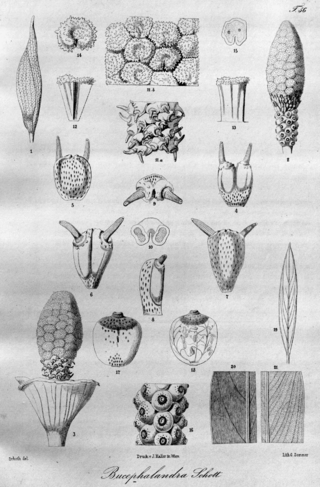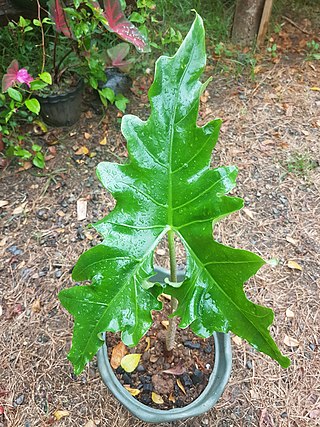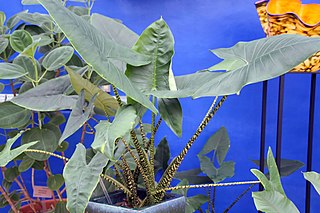
Schismatoglottis is a genus of flowering plants in the family Araceae. Members of the genus are similar in appearance and growth habit to those of the genus Homalomena, but the two genera are not closely related. The primary difference is that the leaves of Schismatoglottis are not aromatic. Schismatoglottis are found primarily in tropical parts of Southeast Asia, New Guinea, and Melanesia. The majority of the species are native to the Island of Borneo.

Bucephalandra is a genus of flowering plants in the family Araceae. There are 30 species of Bucephalandra which have been discovered in Borneo and have been formally described by S.Y. Wong and P.C. Boyce. Most of the species are found in Borneo. Bucephalandra are usually found growing as dense mats over stones or rocks in streams or rivers in moist tropical forest.

Aroideae is a subfamily of flowering plants in the family Araceae. It is the largest subfamily in Araceae and consists of about 72 different genera, and 2,300 species. Many Aroideae have spiny pollen grains without a sporopollenin outer exine layer and lacking an aperture.
Bakoaella is a genus of flowering plants belonging to the family Araceae.
Pursegloveia is a genus of flowering plants belonging to the subfamily Aroideae in the family Araceae.

Alocasia nycteris, commonly known as the bat alocasia or the batwing alocasia, is a plant in the family Araceae. It is endemic to island of Panay in the Philippines. It is cultivated as an ornamental plant.

Alocasia zebrina, commonly known as the zebra plant or zebrina alocasia, is a plant in the family Araceae. It is endemic to the islands of Luzon, Mindanao, Leyte, Samar, Biliran, and Alabat in the Philippines. It is commonly grown as an ornamental plant worldwide. It is also locally known as gabing tigre in Tagalog. It is nationally listed as a threatened species and collection of A. zebrina from the wild is illegal in the Philippines.
Bucephalandra minotaur is a species of flowering plant in the family Araceae, native to Kalimantan on Borneo. It is an obligate rheophyte, found on granite.
Bucephalandra sordidula is a species of flowering plant in the family Araceae, native to Kalimantan on Borneo. It is capable of flowering underwater.
Bucephalandra chimaera is a species of flowering plant in the family Araceae, native to Kalimantan on Borneo. It is an obligate rheophyte, found on granite boulders alongside small streams.
Bucephalandra chrysokoupa is a species of flowering plant in the family Araceae, native to Kalimantan on Borneo. It is an obligate rheophyte, found on granite boulders along riversides.
Bucephalandra ultramafica is a species of flowering plant in the family Araceae, native to Sabah on Borneo. It is found growing on ultramafic rocks alongside rivers.
Bucephalandra kishii is a species of flowering plant in the family Araceae, native to Kalimantan on Borneo. It is a facultative rheophyte, found on granite along high altitude riversides.
Bucephalandra pubes is a species of flowering plant in the family Araceae, native to Kalimantan on Borneo. It is an obligate rheophyte, found on granite rocks and boulders.
Bucephalandra tetana is a species of flowering plant in the family Araceae, native to Kalimantan on Borneo. It is a petite rheophyte, found on mossy granite rocks alongside rivers.
Bucephalandra diabolica is a species of flowering plant in the family Araceae, native to Kalimantan on Borneo. It is a petite obligate rheophyte, found on granite rocks alongside rivers.
Bucephalandra forcipula is a species of flowering plant in the family Araceae, native to Kalimantan on Borneo. It is an obligate rheophyte, found on granite waterfalls.
Bucephalandra oncophora is a species of flowering plant in the family Araceae, native to Kalimantan on Borneo. It is an obligate rheophyte, found on pentlandite alongside streams.
Bucephalandra vespula is a species of flowering plant in the family Araceae, native to Kalimantan on Borneo. It is an obligate rheophyte, found on shady granite rocks along fast-flowing streams.




